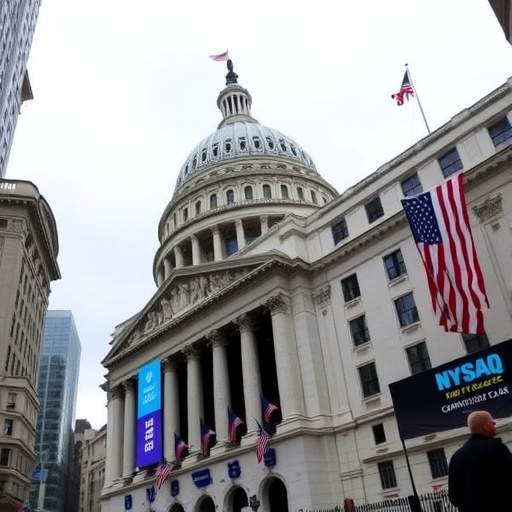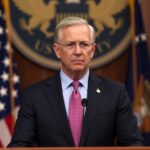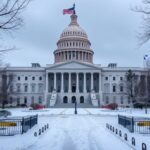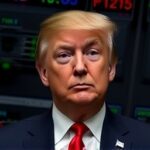In a striking display of market resilience, the S&P 500 and NASDAQ both closed at record highs on Friday, even as the US government shutdown stretches into its third week. This unexpected rally in the Stock market comes amid growing concerns over the government shutdown‘s toll on federal workers and the broader economy, with over 1.4 million employees currently furloughed or working without pay. The S&P 500 climbed 0.9% to 4,797.23, while the NASDAQ jumped 1.3% to 15,115.45, marking their highest levels ever. Investors appear to be shrugging off the political impasse in Washington, focusing instead on robust corporate earnings and hopes for a swift resolution.
- Federal Workers Grapple with Payless Paychecks Amid Shutdown Chaos
- Tech Giants Propel NASDAQ to New Peaks Despite Fiscal Standoff
- S&P 500 Broad Rally Highlights Corporate Strength Over Political Turmoil
- Economists Sound Alarm on Shutdown’s Hidden Economic Toll
- Investor Strategies Shift Toward Diversification in Uncertain Times
Federal Workers Grapple with Payless Paychecks Amid Shutdown Chaos
The government shutdown, now the longest in US history at 21 days, has left federal workers in a precarious financial bind. More than 800,000 employees are furloughed, meaning they are prohibited from working, while another 600,000 are required to report to their jobs without compensation. This unprecedented situation has sparked widespread anxiety, with many turning to food banks, credit cards, and side gigs to make ends meet.
According to the Partnership for Public Service, a nonpartisan advocacy group, the shutdown is costing the economy an estimated $1.5 billion per week in lost wages alone. “These are dedicated public servants who keep our national parks open, secure our borders, and ensure food safety—yet they’re being treated as political pawns,” said Max Stier, the organization’s president. Stories of hardship abound: A Coast Guard lieutenant in Virginia shared on social media how he’s rationing groceries and delaying medical bills, while air traffic controllers at major airports report fatigue from mandatory overtime without pay.
The ripple effects extend beyond individuals. Small businesses near federal installations, such as restaurants and shops in Washington D.C., are seeing a 30% drop in revenue, per data from the National Restaurant Association. As the economic output suffers, questions arise about how long the Stock market can ignore these human costs.
Tech Giants Propel NASDAQ to New Peaks Despite Fiscal Standoff
Leading the charge in Friday’s surge, the NASDAQ was buoyed by standout performances from technology behemoths. Apple shares rose 2.1% after reporting stronger-than-expected iPhone sales in China, while Amazon gained 1.8% on news of expanded Prime delivery services. Microsoft and Alphabet also contributed to the index’s 1.3% gain, underscoring the sector’s dominance in the broader Stock market rally.
This tech-driven momentum isn’t isolated. Over the past week, the NASDAQ has advanced nearly 4%, outpacing other indices amid the government shutdown. Analysts attribute this to investor optimism about artificial intelligence and cloud computing growth, sectors largely insulated from federal budget battles. “The market is pricing in a ‘shutdown premium’—a temporary blip that won’t derail long-term trends,” noted Wedbush Securities analyst Dan Ives in a recent report.
However, not all tech stocks shared in the glory. Companies with heavy government contracts, like Boeing and Lockheed Martin, saw modest declines of 0.5% and 0.3%, respectively, as investors worried about delayed payments affecting cash flow. Despite these pockets of caution, the NASDAQ‘s record close signals strong confidence in innovation-driven growth, even as economic output faces headwinds from the political deadlock.
S&P 500 Broad Rally Highlights Corporate Strength Over Political Turmoil
The S&P 500‘s ascent to 4,797.23 reflects a broad-based rally across sectors, with financials, healthcare, and consumer discretionary stocks all posting gains. JPMorgan Chase led the financial sector with a 1.2% increase following upbeat quarterly results, while Pfizer climbed 1.5% on promising vaccine trial data. This diversification underscores why the stock market is hitting highs despite the government shutdown.
Market data from Bloomberg shows that since the shutdown began on December 22, the S&P 500 has gained over 5%, erasing early-year losses. Contributing factors include the Federal Reserve’s recent pivot away from rate hikes and seasonal end-of-year buying. “Corporate America is delivering results that transcend Washington gridlock,” said BlackRock investment strategist Ricky Revesz. He pointed to earnings growth projections of 12% for 2024, driven by efficiency gains and global demand.
Yet, beneath the surface, vulnerabilities lurk. The shutdown’s impact on economic output is estimated at $11 billion so far by the Congressional Budget Office, potentially shaving 0.1% off fourth-quarter GDP. Sectors tied to government spending, such as defense and transportation, could face prolonged pressure if the impasse continues, testing the S&P 500‘s resilience.
Economists Sound Alarm on Shutdown’s Hidden Economic Toll
As the stock market celebrates records, economists are issuing stark warnings about the government shutdown‘s broader repercussions. The ongoing crisis is not just halting services but eroding consumer confidence and business investment. A Moody’s Analytics report forecasts that prolonged disruption could reduce US economic output by up to $18 billion by January’s end, with indirect costs from delayed IRS tax refunds and postponed infrastructure projects adding to the burden.
“This isn’t a zero-sum game; the shutdown is like sand in the gears of the economy,” warned Mark Zandi, chief economist at Moody’s. He highlighted how furloughs are curbing holiday spending, with retail sales potentially down 2-3% in affected regions. Unemployment claims have ticked up slightly, and small business optimism indices from the National Federation of Independent Business have dipped for the first time in months.
International observers are watching closely too. The International Monetary Fund noted in a recent briefing that US fiscal instability could ripple globally, pressuring emerging markets reliant on American trade. Domestically, food inspection delays at the USDA have already led to $160 million in agricultural export losses, per industry estimates. While the S&P 500 and NASDAQ soar, these cracks suggest the economic output damage may soon catch up if lawmakers don’t act.
Quote from a Senate Democrat: “The markets may be optimistic, but families aren’t. We need to end this shutdown now to protect our economy.” On the Republican side, a House leader countered, “Fiscal responsibility can’t wait—passing a clean bill without reforms would be irresponsible.” This partisan divide keeps the government shutdown alive, fueling uncertainty.
Investor Strategies Shift Toward Diversification in Uncertain Times
With the stock market defying the government shutdown, investors are adapting their portfolios to weather potential storms. Financial advisors recommend bolstering holdings in defensive sectors like utilities and consumer staples, which gained 0.7% and 1.1% respectively on Friday. Exchange-traded funds tracking the S&P 500, such as SPY, saw inflows of $2.3 billion last week, indicating sustained bullishness.
Options trading volume spiked 15% on the NASDAQ, with traders hedging against volatility from shutdown news. “Diversification is key—don’t bet everything on tech when politics could upend sentiment,” advised Fidelity’s Jurrien Timmer. Gold prices, often a safe-haven asset, rose 0.4% to $2,065 per ounce, reflecting some flight to safety.
Looking ahead, the January 6 deadline for debt ceiling talks looms large, intertwined with shutdown resolution. If Congress fails to act, credit rating agencies like S&P Global could downgrade US debt, historically triggering market sell-offs. Yet, historical precedents—like the 2018-2019 shutdown—show recoveries are swift once deals are struck, bolstering hopes for the S&P 500 and NASDAQ to extend gains.
As negotiations intensify, market watchers eye upcoming economic data, including December jobs numbers, for clues on economic output resilience. A strong report could further detach Wall Street from Washington’s woes, but weakening indicators might finally pierce the stock market‘s armor. For now, the rally persists, a testament to economic momentum outpacing political paralysis, though the path forward remains fraught with risks.









